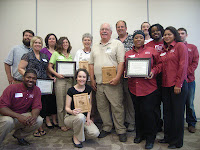Nice article from the LaSalle News Tribune on invasvie species efforts at Starved Rock
See the original article
HERE.
--
Mendota man battles non-native plants
By Jeff Dankert
To restore and maintain native plants, Bryon Walters wages war.
The 53-year-old conservation biologist from Mendota cuts down invasive non-native plants and when that doesn’t work, he turns to chemical warfare.
Walters fights on many fronts through his one-man company, Illinois Natural Areas Improvements.
Most recently Starved Rock State Park called Walters to attack a grove of black locust trees and other non-native plants at the park’s west entrance.
“That just helps out whenever you get rid of the negative component, the natives have a better chance of prospering and flourishing,” Walters said. “You need to tend to it like a garden. You can’t just let it sit idle.”
Walters, with assistance of state forester Randy Timmons, arborist Scott Shearer and a tree crew, cut down the locusts. This tree is native to the southeastern U.S. and far southern Illinois but has been widely transplanted beyond its native range. Walters treated the cut stumps with glyphosphate to prevent re-sprouting.
If the locust was the only problem, Walters’ job would be easier.
“We cleared the black locust but there’s a plethora of exotics underneath,” Walters said.
This week he returned with a backpack sprayer filled with 2,4-D and tricoplyr to drive back other aggressive invaders. He moved across the slope and jetted a blue spray on bull thistle, cutleaf teasel, poison hemlock, burdock and others. He also identified non-native reed canary grass, common buckthorn, catnip, garlic mustard and Asian honeysuckle.
The teasel from Europe has spread along roadsides through regular mowing, which disperses seeds, Walters said. It creates “a trail of teasel,” he said.
Herbicides are a last resort on natural areas. But when mechanical means like pulling or cutting don’t work, you have to use chemicals or you lose the battle, Walters said.
Park superintendent Mark McConnaughhay said he turns to Walters for burning prairies to spraying patches of aggressive and out-of-place plants, with guidance of Illinois Department of Natural Resources district heritage biologist Dan Kirk. A state Natural Area Acquisition Fund helps pay for Walters’ services.
Walters began his natural resources career as a bird biologist but realized bird surveys were not going to pay the bills. A professional acquaintance nudged him toward vegetation management. That was 25 years ago. Walters has been busy.
“It’s a job that’s always going to be there,” Walters said.
He began his new career with classes at Morton Arboretum and volunteering with The Nature Conservancy, he said. His job requires broad knowledge of botany and plant ecology and skills using field equipment. He must remain licensed and certified as a pesticide applicator.
The public has misperceptions about his work, about plants and about their interactions on the landscape, Walters said.
“They assume these areas take care of themselves and they don’t,” he said. “Careful thought needs to be put into how you plant and how you landscape to preserve our natural biodiversity.”
The North American landscape once took care of itself. After Europeans invaded, the landscape was patch-worked into crop fields. Agriculture, industry, transportation and technology rapidly altered the land. Intentional plantings and accidental introductions began replacing native plants. It wiped out 99 percent of the natural areas of Illinois, Walters said.
“No other state is more altered than Illinois,” he said. “Our ecosystem can’t take this constant barrage.”
Illinois’ economic drivers of agriculture and industry mostly trump care for flora and fauna, Walters said.
This makes something like Starved Rock State Park “an oasis in an agricultural and industrial area,” he said.
Native landscapes could have played an economic role in the most obvious, recent example of record floods.
Native grasslands and wetlands filter and soak up water. If they were restored on a scale that mattered, this could have saved the state and its citizens billions of dollars, Walters said.
For the first time in years, the south slope along the park entrance provides a locust-free view of the limestone cliffs and native plants like witch hazel, red-berried elderberry, pagoda dogwood, white pines, Solomon’s seal, bloodroot, Dutchman’s breeches, yellow bellwort, Canada anemone and others.
The west entrance once hugged the bluff. It was later elevated and the sloping shoulder was planted with black locusts, considered a good choice for soil erosion. It was a bad choice. It is not native; it shades out spring wildflowers; and it is allotropic, giving off chemicals that prevent competition from other plants. Asian honeysuckle also is allotropic, Walters said.
“Honeysuckle, it’s the No. 1 plant we need to go after statewide,” he said.
There are native honeysuckles but these are seldom grown and sold, he said.
The site will require many visits to eradicate invasive plants. Walters will revisit the locust patch in two to three weeks. The site has a good base of natives, growing and with seed in the soil, so Walters won’t have to plant any natives, he said.
This fall, he will use a controlled burn to further knock back invasive plants, reduce some of the locust timber and encourage more natives.
“Because we fragment the land, it’s an ongoing process,” Walters said. “It’s a long road for that recovery.”
Jeff Dankert can be reached at (815) 220-6977 or perureporter@newstrib.com.







